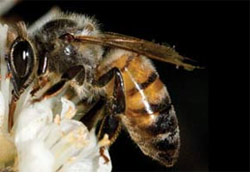

Research on bees conducted by an USP group has broadened knowledge on the relationship between genes and hormones that control the process of exoskeleton shedding in insects. The study was published in PLoS One (photo:NBII)
Formed by the epidermis and the exoskeleton, the integument of insects is largely responsible for the evolutionary success and mega-diversity of this group of organisms.
Formed by the epidermis and the exoskeleton, the integument of insects is largely responsible for the evolutionary success and mega-diversity of this group of organisms.

Research on bees conducted by an USP group has broadened knowledge on the relationship between genes and hormones that control the process of exoskeleton shedding in insects. The study was published in PLoS One (photo:NBII)
By Fábio de Castro
Agência FAPESP – Formed by the epidermis and the exoskeleton, the integument of insects is largely responsible for the evolutionary success and mega-diversity of this group of organisms.
A study conducted on bees by scientists from Universidade de São Paulo (USP) has broadened knowledge on the influence ecdysteroid hormones – which control ecdysis, or the process of shedding the exoskelton during an insect’s development - exert on cuticular genes.
The study, published in PLoS One, was conducted under the auspices of the Thematic Project “Functional genomic of Apis mellifera: search for new genes and functional networks in the context of development, different basts and reproduction,” funded by FAPESP and coordinated by Professor Zilá Simões, of the Bee Development Laboratory (LBDA) at USP in Ribeirão Preto (SP).
Ten years ago, an LBDA research line coordinated by Professor Márcia Bitondi sought to understand the ontogenetic scenario of the formation and differentiation of the insect exoskeleton utilizing the Apis mellifera as a biological model.
Bitondi coordinated the “Molecular genetics and hormonal regulation of exoskeleton differentiation in an insect model, Apis mellifera)", funded by FAPESP under its Regular Research Awards.
In addition to Bitondi and Simões, the article is co-authored by Michelle Soares and Fernanda Silva-Torres, along with contributors Moysés Elias-Neto and Francis Nunes. Elias-Neto and Nunes are FAPESP doctoral and post-doctorate fellows, respectively.
In the article, the group investigates the influence of ecdysteroid hormones on regulation of cuticular gene expression. “The cycle reconstruction during the growth and metamorphosis of insects involves a complex network between the action of enyzmes and the synthesis of structural proteins. This whole process is under the control of ecdysteroids, which act as veritable conductors of development,” Bitondi told Agência FAPESP.
According to the researcher, in the course of the study on the gene encoding cuticle proteins of Tweedle and the Peroxidase enzyme, scientists confirmed the relationship between hormonal levels, gene expression and cuticular maturation during the cycle of exoskeleton shedding.
“We conducted analysis of both messenger RNA transcripts and proteins at different stages of development and in distinct regions of the bee’s body, which allowed for a general outlook on the temporal and spatial standards of gene expression,” she affirms.
According to Elias-Neto, in earlier studies the lab team had already identified other structural proteins and enzymes that participated in the process of integument differentiation.
By identifying the participation of genes encoding structural cuticle proteins and peroxidase enzymes, the group, which is focused on biological development, took another step toward understanding how exoskeletons form in insects.
“After including these new molecular personalities in the set of cuticular components that were previously investigated by the group, our next challenge will be to relate the dynamics of exoskeleton ontogenesis to the complex peculiarities of the social lives of bees,” explains Elias-Neto.
According to him, throughout a bee’s development, the oscillation of hormonal rates is what coordinates gene expression standards. The study’s differential, according to him, is that fact that it relates the context of exoskeleton development to specificities of a social insect.
According to Nunes, the major contribution of this line of research in the international scientific scenario consists precisely of uncovering the similarities and differences in the formation of the exoskeleton among social and non-social insects.
“This opens a broad margin for new studies. The questions now will be directed to the difference between the integuments of social and non-social insects,” he says.
The article Ecdysteroid-dependent expression of the tweedle and peroxidase genes during adult cuticle formation in the honey bee, Apis mellifera (doi:10.1371/journal.pone.0020513) can be accessed at PLoS One.
Republish
The Agency FAPESP licenses news via Creative Commons (CC-BY-NC-ND) so that they can be republished free of charge and in a simple way by other digital or printed vehicles. Agência FAPESP must be credited as the source of the content being republished and the name of the reporter (if any) must be attributed. Using the HMTL button below allows compliance with these rules, detailed in Digital Republishing Policy FAPESP.





